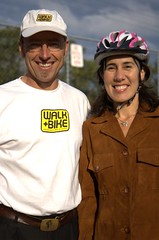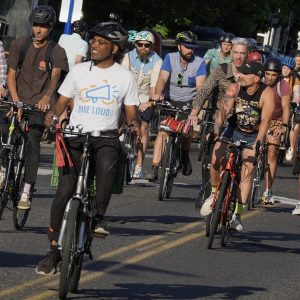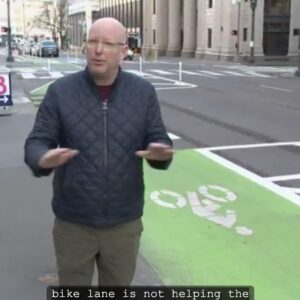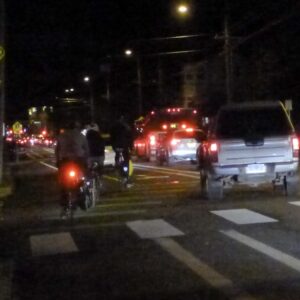
As you might have heard, the Speaker of the U.S. House of Representatives, Nancy Pelosi, was in Portland last week for a forum on global warming put together by Congressman Earl Blumenauer.
A bunch of energy wonks in a room full of politicos might not seem like a big deal to you, but Pelosi is not just another politician. She’s second in line to the U.S. presidency (behind Dick Cheney) and with Democrats controlling Congress, she is in a position to make things happen.
The big deal for bikes is that among the 40 or so people in the invite-only crowd at the forum on Wednesday was none other than former PDOT bike coordinator-turned consultant Mia Birk.

Ping of the Safe Routes to School
National Partnership.)
(Photo: Jonathan Maus)
Birk was one of several folks Blumenauer planted around the room who he then called on to give Pelosi (and others around the table including State Senate President Peter Courtney and Congresswoman Darlene Hooley) a short overview on how Portland is meeting environmental challenges.
After hearing from TriMet General Manager Fred Hansen, Birk shared a snapshot of Portland’s bike story with Pelosi. Birk says she told Pelosi that back in the ’90s, “Portland started a big experiment to see if we could retrofit a large, urban city and make it work for bikes.” After explaining how it has clearly worked so far, Birk also plugged Portland’s burgeoning Safe Routes to School program.
After Birk’s presentation, Blumenauer brought up how bikes have helped spur economic activity in Portland.
According to an aide for Blumenauer, the information resonated with Pelosi and she talked about what she heard the rest of the day.
Portland’s bike story is becoming more and more well-known in the halls of Congress these days. It makes me wonder if there will be an opportunity in the next Federal Transportation Bill to allocate a special set of funds to help us get to the next level of bike-friendliness. We’ve taken great strides already, but we’ve done it with relatively paltry amounts of spending on bicycle-specific infrastructure and it’s been several years since major improvements have been added to our bikeway network.
I’d say we’re definitely front-runners to be one of 40 communities that might be chosen to receive $50 million each to be spent on non-motorized transportation projects as part of the Rails-to-Trails Conservancy’s 2010 Campaign for Active Transportation that will be written into the upcoming Transportation Bill.
Just imagine what we could do with that kind of money…






Thanks for reading.
BikePortland has served this community with independent community journalism since 2005. We rely on subscriptions from readers like you to survive. Your financial support is vital in keeping this valuable resource alive and well.
Please subscribe today to strengthen and expand our work.
Jonathan, I would like to hear your ideas on what could be done with that kind of money. How would you spend it if you could?
\”Jonathan, I would like to hear your ideas on what could be done with that kind of money. How would you spend it if you could?\”
Two things:
Sullivan\’s Gulch Trail
North Portland Greenway Trail
Get them built. pay off landowners. make it happen. fast!
I would comment that while there are improvements which can be made to the East side, we should prioritize a good portion of money for the west side where about 1% of the population bikes. Let\’s get the very unfriendly areas running so that we can have a cohesive city.
It was great that the Speaker came to Portland (due to the efforts of Rep. Blumenauer) and heard not just from Mia but from members of the development community who really get the need to \”green\” our cities, not just in transportation but in buildings and energy use. (Mark Edlen, John Carroll and Hank Ashforth spoke).
But we shouldn\’t be satisfied with \”budget dust\”, which is what $50M is, when the transportation bill will be over $300 Billion over 6 years. What we need, and Metro has been advocating for, is truly flexible funding, with the same set of requirements for all modes. Right now, transit must jump through many hoops, bikes and peds are treated as \”amenities\” rather than the superior urban transport they are and highways get a free ride: no requirement for repair and replacement funding (can you say OTIA?), no outcomes or performance measures other than increased traffic (what value does that have?). A level playing field and recognition that urban/metro transportation needs are totally different than inter-city/interstate needs will make the difference.
With leaders like Peter DeFazio (D-OR) and Blumenauer in key positions, we need to demand that our tax dollars are spent on achieving the outcomes we desire: healthy citizens, healthy economies, healthy cities, healthy environment.
A good way to keep track of this issue is through the Surface Transportation Policy Project http://www.transact.org. 2008 will be the pivotal time for energy, climate change, and transportation legislation on the federal level.
Rex
My husband and I live in bike-friendly Corvallis; just wanted to say thatyour wonderful efforts up there in PDX make it oh so easy for us to come up on the train with our bikes and spend a pleasant day or weekend getting errands done and doing fun things. I am awed by your joie de cycling, energy and commitment. We\’ll keep fingers crossed that more comes out of Pelosi\’s visit….Claire
I would love to see funds being spent on bike friendly roads and more space for bikes on public transportation.
I was on the MAX yesterday and there were so many bikes that needed to get on the train from Hillsboro to Portland. If bike hooks were added to the ends of current trains, you could fit up to 10 bikes on the end of each train (1 hook would be added to the each side where current hooks are, and then 3 added to each side of the handicap seating area.
I would not want to take up people space with bikes or people with handicaps and get them angry at bikes, but…..if there was a 3rd train added to some of the trains during rush hour and the ends of the trains were designated as bike areas only during the hours of 4:30pm-6:30pm (a sign could be posted that said something like \”Bikes only during 4:30pm-6:30pm,\” similar to carpool lane hours), there would be more room for bike commuters and pedestrians. People would still have their seats towards the front, middle and back of the train and there would be 20 spots for bikes.
Just a thought…..the problem seems to get worse and worse each year.